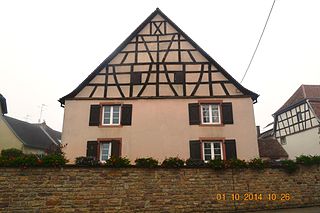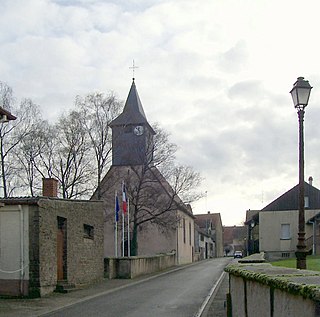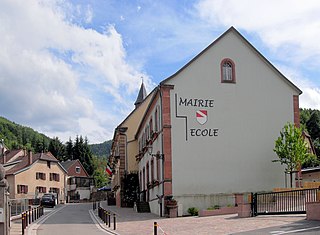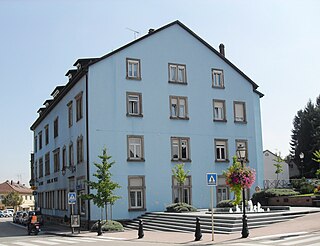
Alsace is a cultural region and a territorial collectivity in eastern France, on the west bank of the upper Rhine next to Germany and Switzerland. In January 2021, it had a population of 1,919,745. Alsatian culture is characterized by a blend of German and French influences.

Bas-Rhin is a département in Alsace which is a part of the Grand Est super-region of France. The name means 'Lower Rhine', referring to its lower altitude among the two French Rhine departments: it is downstream of the Haut-Rhin department. Both belong to the European Upper Rhine region. It is, with the Haut-Rhin, one of the two departments of the traditional Alsace region which until 1871, also included the area now known as the Territoire de Belfort. The more populous and densely populated of the pair, it had 1,152,662 inhabitants in 2021. The prefecture is based in Strasbourg. The INSEE and Post Code is 67.

Haut-Rhin is a département in the Grand Est region, France, bordering both Germany and Switzerland. It is named after the river Rhine. Its name means Upper Rhine. Haut-Rhin is the smaller and less populated of the two departments of the former administrative Alsace region, the other being the Bas-Rhin. Especially after the 1871 cession of the southern territory known since 1922 as Territoire de Belfort, although it is still rather densely populated compared to the rest of metropolitan France. It had a population of 767,083 in 2021.

La Bastide-Clairence is a commune in the Pyrénées-Atlantiques department in the Nouvelle-Aquitaine region of south-western France.

The arrondissement of Altkirch is an arrondissement of France in the Haut-Rhin department in the Grand Est region. It has 108 communes. Its population is 69,793 (2016), and its area is 663.1 km2 (256.0 sq mi).

Banville is a commune in the Calvados department in the Normandy region of north-western France.

Ensisheim is a commune in the Haut-Rhin department in Grand Est in north-eastern France. It is also the birthplace of the composer Léon Boëllmann. The Germanic origins of the village's name reflect the area's history.

Soultz-Haut-Rhin is a commune in the Haut-Rhin département in Grand Est in north-eastern France.

Andlau is a commune in the Bas-Rhin department in Alsace, Grand Est region of northeastern France.

Asswiller is a commune in the Bas-Rhin department in the Grand Est region of north-eastern France.

Altwiller is a commune in the Bas-Rhin department in the Grand Est region of northeastern France.

Allenwiller is a former commune in the Bas-Rhin department in the Grand Est region of northeastern France. On 1 January 2016, it was merged into the new commune Sommerau.

Balbronn is a commune in the Bas-Rhin department in the Grand Est region of north-eastern France.

Barembach is a commune in the Bas-Rhin department in the Grand Est region of north-eastern France.

Bassemberg is a commune in the Bas-Rhin department in the Alsace region of north-eastern France.

Herrlisheim is a commune in the Bas-Rhin department in Grand Est in north-eastern France. The town dates from the 8th century. Herrlisheim was the scene of very heavy fighting during Operation Nordwind, an offensive launched by the German Army during World War II that inflicted considerable damage to the town.

Buhl is a commune in the Haut-Rhin department in Grand Est in north-eastern France.

Frœningen is a commune in the Haut-Rhin department in Alsace in north-eastern France.

Hégenheim is a commune in the Haut-Rhin department in Alsace in north-eastern France. It is adjacent to the Swiss town of Allschwil, and is part of the Basel urban area.

The history of the Jews in Alsace is one of the oldest in Europe. It was first attested to in 1165 by Benjamin of Tudela, who wrote about a "large number of learned men" in "Astransbourg"; and it is assumed that it dates back to around the year 1000. Although Jewish life in Alsace was often disrupted by outbreaks of pogroms, at least during the Middle Ages, and reined in by harsh restrictions on business and movement, it has had a continuous existence ever since it was first recorded. At its peak, in 1870, the Jewish community of Alsace numbered 35,000 people.
























